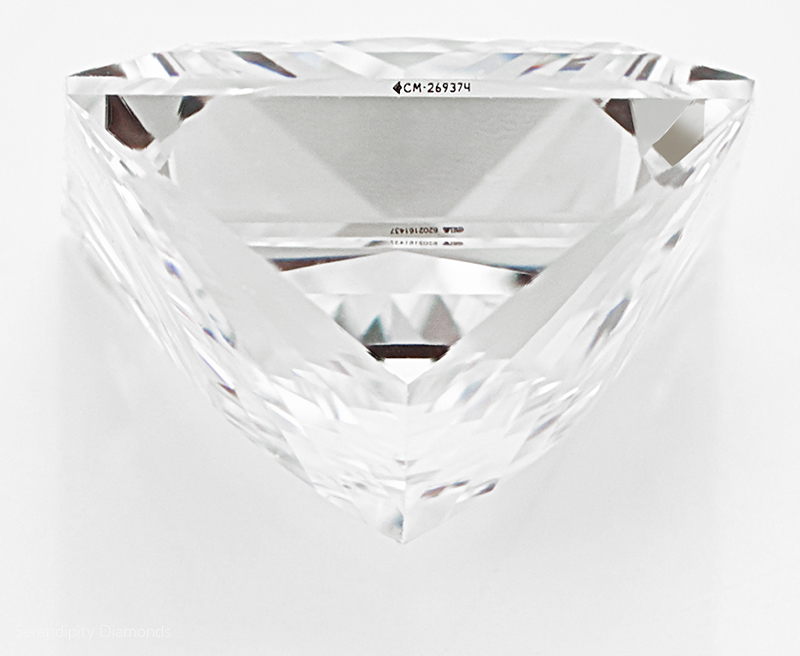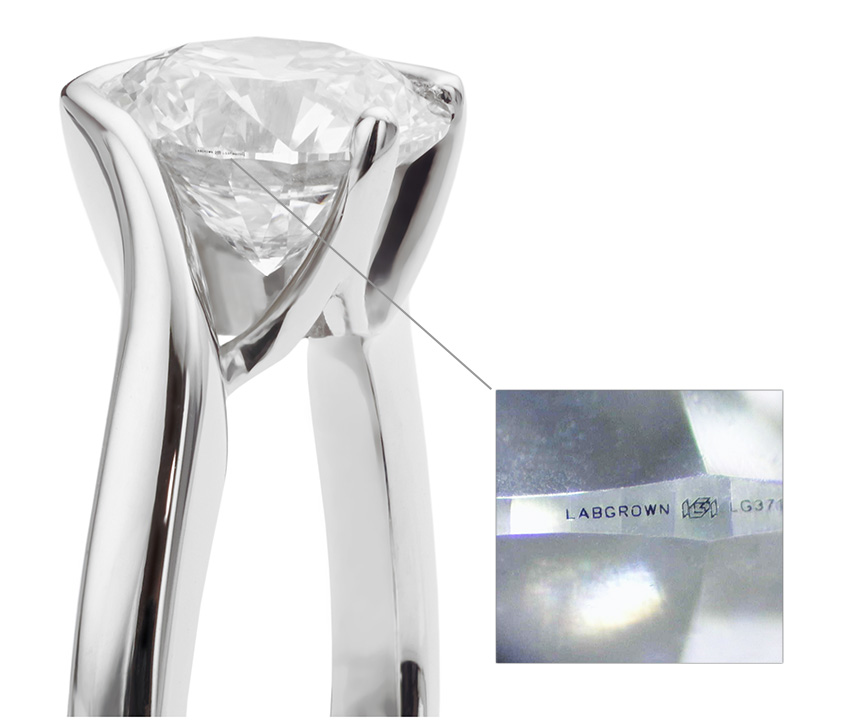What is a GIA laser inscription?
Diamonds accompanied by GIA Diamond Dossiers® typically feature a micro-laser inscription on the edge of the diamond. This certificate number appears in microscopic digits of the side of the diamond.
The diamond laser inscription identifies the diamond and connects it to a unique diamond grading report, also known as a diamond certificate.
The GIA report number appears microscopically engraved on the outer girdle of the diamond. The laser inscription gives buyers a unique way of linking their GIA report to the diamond itself.
Buyers use an online report check to enter this number on GIA’s website to receive an electronic copy of the original diamond grading report.
Where to find the girdle of a diamond
The girdle of your diamond runs around the outer edge between the upper crown facets and the lower pavilion facets.
This thin outer edge separates the upper part of the diamond from the lower section. The polished, faceted or bruited (matt) girdle includes the number applied microscopically.
But why would anyone need a GIA laser inscription on their diamond? In simple terms, the inscription gives the consumer greater confidence when purchasing a diamond.
Many retailers use this as a further selling point. Not all laboratories laser mark diamonds in this way. GIA records the stone under this number in their online archive.
The GIA inscription is invisible to the naked eye and difficult to see under 10x magnification to the untrained eye. Very few buyers see this number owing to the tiny size of the digits. From experience, buyers who purchase without consultation are likely unaware of the inscription’s presence.
BRAND NEW SERVICE!! We now offer the option to have customised wording lasered on the girdle of your diamond using a precision laser beam. Please inquire for more information on this bespoke service. Please note this service is only available on diamonds sourced via Serendipity Diamonds.

Before choosing the ring design, we can provide any GIA-certified diamond housed within a ring clip and presented in the same way as an engagement ring.
How to buy a setting for your GIA inscribed diamond.
For private buyers or jewellers who already own their own GIA diamond, we create finished ring mounts based on any of our designs. Watch our short video explaining our finished ring mounts service.
Why is the GIA laser inscription useful?
Diamond merchants, jewellery retailers and manufacturers handle a large volume of certified diamonds below 1 carat in weight.
Retailers often source selections of similar diamonds to show clients during a visit. These diamonds often vary so slightly that they appear identical to the inexperienced eye.
Similar-looking diamonds are easily mixed up and require a system for checking them back into their parcels. For example, imagine the confusion from showing a client three near-identical diamonds—all identical in size, clarity and just one colour difference.
As a result, small diamonds matched to their certificate numbers help to identify each diamond according to its inscription correctly. Retailers must check diamonds back into parcels.

The problem with GIA laser inscriptions
We have already touched upon the microscopic size of the laser inscription. Tiny numbers pose a problem for many people who don’t have the knack or trained eye while using a 10x loupe.
Manufacturers, retailers and consumers need to be able to view their inscriptions, but the size makes this an arduous task. The inscription size needs to be microscopic to fit discreetly onto the girdle and to ensure the beauty of the diamond is unaffected.
What is the best magnification to view a diamond inscription?
Based on the magnification of the viewer we sell (see below), the magnification is 20x. It will always take a little time to set up to view the inscription, but provided the number is not too faint, it should be visible at this magnification. For most people, a standard diamond loupe (10x) will struggle to provide enough magnification to read the full number.
Useful tools for viewing the GIA laser inscription
If you want to make viewing more manageable, we recommend the Laser inscription viewer. This handy well-constructed device works with a diamond held within a ring mount or ring clip. An adjustable magnifying glass rests at the end of an arm, which glides effortlessly around the diamond’s outer edge, allowing the user to scan for the GIA inscription.
Once found, adjust the lens for a clear view of the GIA number. It will take the user a little time to become acquainted with the viewer, but using this instrument will make the inscription readable.
As a bonus, the viewer includes a hearts & arrows viewer for loose diamonds concealed within the scope’s body. (Shown here alongside the inscription viewer.)
Advice for purchasing with a GIA laser inscription
If you buy a GIA-certified, laser-inscribed diamond, consider the following information.
1. In-store – ensure that your retailer has a viewer so that you can see this critical feature of the diamond. Many buyers do not require this level of detail, but some clients enjoy the reassurance of seeing their inscription.
2. If you decide upon a GIA-certified diamond engagement ring with a laser inscription, speak to your jeweller about positioning the diamond so that the number remains visible when the diamond goes into the ring. Most diamond rings feature claws or settings that obscure the inscription on the edge of the diamond.
Finally, if you are looking for a specific GIA-certified diamond, we feature an extensive catalogue of GIA-certified diamonds on our website as part of our loose diamond service. Some even feature traceability back to the mine of origin. (See our GIA CanadaMark range or contact us about traceable diamonds or for help sourcing the perfect stone.)
Other types of serial numbers on certified diamonds
GIA inscriptions are not the only number found on a diamond. Additional serial numbers accompany different types of diamonds. At Serendipity, we specialise in being able to supply diamonds that are traceable back to the very mine from where they originated.
All the Canadamark diamonds available via Serendipity Diamonds include GIA certification, proof of origin and a Canadamark card with a note of the rough and polished diamond weights.
CanadaMark Inscriptions on diamonds
The following image shows the “Canadamark” serial number accompanying the diamond from rough to polished stone. Look closely, and you can also see the GIA number reflected from the opposite girdle.
Contact us if you want us to source a diamond with traceability back to the mine of origin. Please note that our CanadaMark diamonds include the laser-inscribed GIA and CanadaMark numbers.

Please ask us about fully traceable CanadaMark diamonds available at Serendipity Diamonds.
Inscriptions on Lab-grown diamonds
Lab-grown diamonds and natural diamonds look identical, even to a trained eye. For this reason, human-made diamonds feature a laser inscription on the rock to this effect. Viewed through our inscription reader, the diamond certificate number and reference to lab-grown appear on the edge of the stone.
Further reading
Don’t forget to read our detailed article explaining how to read your GIA diamond grading report.
About Mark Johnson
My name is Mark and I'm founder at Serendipity Diamonds. I have 30 years or experience in polished diamonds and jewellery. Today, I work with an expert team in our Isle of Wight jewellery showroom located in Ryde. Most of my work involves helping clients in our showroom, working on our two websites and photographing jewellery commissions.





